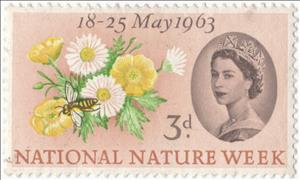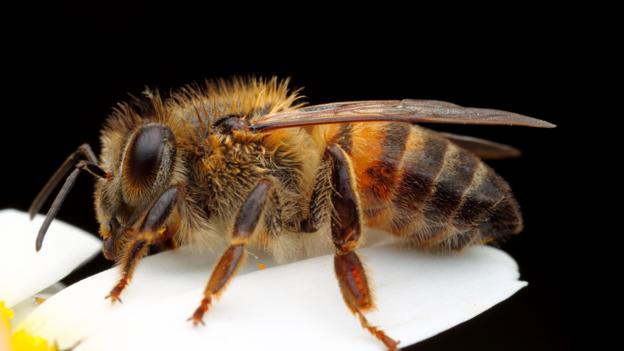Stamp: Buttercup, Common Daisy, Honey Bee (Apis sp.) - Phosphor (United Kingdom of Great Britain & Northern Ireland 1963)
Buttercup, Common Daisy, Honey Bee (Apis sp.) - Phosphor (United Kingdom of Great Britain & Northern Ireland 1963)
16 May (United Kingdom of Great Britain & Northern Ireland ) within release National Nature Week goes into circulation Stamp Buttercup, Common Daisy, Honey Bee (Apis sp.) - Phosphor face value 3 British penny
| Stamp Buttercup, Common Daisy, Honey Bee (Apis sp.) - Phosphor in catalogues | |
|---|---|
| Stanley Gibbons: | Sg: GB 637pa |
Stamp is horizontal format.
Plate flaw:'Caterpillar' flaw.Also in the issue National Nature Week:
- Stamp - Buttercup, Common Daisy, Honey Bee (Apis sp.) face value 3;
- Stamp - Buttercup, Common Daisy, Honey Bee (Apis sp.) - Phosphor face value 3;
- Stamp - European Badger (Meles meles), Roe Deer (Capreolus capreolus face value 4½;
- Stamp - European Badger (Meles meles), Roe Deer (Capreolus capreolus face value 4½;
- Stamp - Buttercup, Common Daisy, Honey Bee (Apis sp.) - Phosphor face value 3;
Stamp Buttercup, Common Daisy, Honey Bee (Apis sp.) - Phosphor it reflects the thematic directions:
Animals are multicellular, eukaryotic organisms of the kingdom Animalia (also called Metazoa). All animals are motile, meaning they can move spontaneously and independently, at some point in their lives. Their body plan eventually becomes fixed as they develop, although some undergo a process of metamorphosis later on in their lives. All animals are heterotrophs: they must ingest other organisms or their products for sustenance.
Bees are winged insects closely related to wasps and ants, known for their roles in pollination and, in the case of the best-known bee species, the western honey bee, for producing honey. Bees are a monophyletic lineage within the superfamily Apoidea. They are currently considered a clade, called Anthophila. There are over 20,000 known species of bees in seven recognized biological families. Some species – including honey bees, bumblebees, and stingless bees – live socially in colonies while most species (>90%) – including mason bees, carpenter bees, leafcutter bees, and sweat bees – are solitary.
Environmental protection is the practice of protecting the natural environment by individuals, groups and governments.Its objectives are to conserve natural resources and the existing natural environment and, where it is possible, to repair damage and reverse trends.
A flower, sometimes known as a bloom or blossom, is the reproductive structure found in plants that are floral (plants of the division Magnoliophyta, also called angiosperms). The biological function of a flower is to effect reproduction, usually by providing a mechanism for the union of sperm with eggs. Flowers may facilitate outcrossing (fusion of sperm and eggs from different individuals in a population) or allow selfing (fusion of sperm and egg from the same flower). Some flowers produce diaspores without fertilization (parthenocarpy). Flowers contain sporangia and are the site where gametophytes develop. Many flowers have evolved to be attractive to animals, so as to cause them to be vectors for the transfer of pollen. After fertilization, the ovary of the flower develops into fruit containing seeds. In addition to facilitating the reproduction of flowering plants, flowers have long been admired and used by humans to beautify their environment, and also as objects of romance, ritual, religion, medicine and as a source of food.
Insects (from Latin insectum, a calque of Greek ἔντομον [éntomon], "cut into sections") are a class (Insecta) of hexapod invertebrates within the arthropod phylum that have a chitinous exoskeleton, a three-part body (head, thorax and abdomen), three pairs of jointed legs, compound eyes and one pair of antennae. They are the most diverse group of animals on the planet, including more than a million described species and representing more than half of all known living organisms. The number of extant species is estimated at between six and ten million, and potentially represent over 90% of the differing animal life forms on Earth. Insects may be found in nearly all environments, although only a small number of species reside in the oceans, a habitat dominated by another arthropod group, crustaceans. The life cycles of insects vary but most hatch from eggs. Insect growth is constrained by the inelastic exoskeleton and development involves a series of molts. The immature stages can differ from the adults in structure, habit and habitat, and can include a passive pupal stage in those groups that undergo 4-stage metamorphosis (see holometabolism). Insects that undergo 3-stage metamorphosis lack a pupal stage and adults develop through a series of nymphal stages. The higher level relationship of the Hexapoda is unclear. Fossilized insects of enormous size have been found from the Paleozoic Era, including giant dragonflies with wingspans of 55 to 70 cm (22–28 in). The most diverse insect groups appear to have coevolved with flowerin plants.
Flora is the plant life occurring in a particular region or time, generally the naturally occurring or indigenous—native plant life. The corresponding term for animal life is fauna. Flora, fauna and other forms of life such as fungi are collectively referred to as biota. Sometimes bacteria and fungi are also referred to as flora, as in the terms gut flora or skin flora.
Special Occasions







